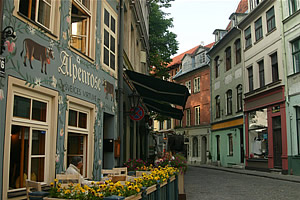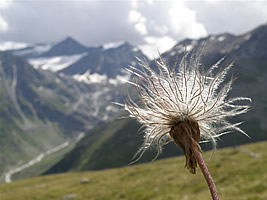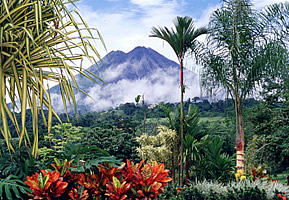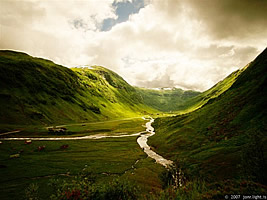Colombia is in the Top 10 of all Eco-Friendly Countries
By chili,
December 3rd 2009 in Travel
Destinations
The environment is a big
and serious issue, but it is not as bad as you might believe
when thinking about the condition of our planet. Yes, there
are extremely badly polluted places on our Earth (see Most
Polluted Cities) that cry out to heaven for vengeance,
but fortunately, some areas and even entire countries where
the air is fresh and invisible (as it is supposed to be),
the water stays crystal blue (and not poisonous and dark)
do exist around the globe.
The Columbia University's
Center for International Earth Science Information Network
and Yale University's Center for Environmental Law and Policy
have published a list of the world's cleanest countries.
The Environmental Performance Index (EPI), created by the
universities, ranks the countries by such indicators as
polices on environmental health, air pollution, climate
change, water resources, productive natural resources, as
well as biodiversity and habitat.
Here we present
the top ten (out of 149 surveyed countries) cleanest and
eco friendly states:
10. France

Tree and lavender fields. By vathiman
Apparently, European states
account for 14 of the top 20 world's cleanest countries,
and France,
with its green policy, ranks tenth on this eco list. Climate
change is one of the biggest issues for the French government
and therefore, various steps have been taken in order to
keep the country clean and green. France has ratified the
Kyoto Protocol and is committed to reduce its greenhouse
gases emission by 5.2% from the 1990 level. In 2004, France
closed down its last coal mine, and now gets 80% of its
electricity from nuclear power, so CO2 emissions are relatively
low.
Moreover, the green policy
is also reflected in such actions as public system improvement
- fast trains, metros, bike programs, introducing taxes
on cars, packaging, plastic products, electronic devices,
and batteries, suspending GM commercial crops and investing
in new energy sources.
9. Colombia

Coffee plant. Colombia. By anthrotect
According to the ranking,
Colombia
is the second cleanest country in the Americas and world's
ninth cleanest state. After years of deforestation linked
to the conversion of large areas to illegal coca plantations
and oil palm plantations, the country is now moving toward
ecological standpoints by supporting the eco-friendly agricultural
policies. The country scored 99.9 of EPI index in the category
of cropland policy - around 40% of agriculture areas remain
uncultivated at any given time so the soil is allowed to
lie fallow.
For many years, globetrotters
were warned against traveling to Colombia due to the armed
conflict, drug violence and kidnappings, but today the country
gets back on the track, especially thanks to improving security
situation. Among main travelers' magnets is the country's
abundant nature, amazing biodiversity, breathtaking landscapes
of glaciers, rain forests and clean, empty beaches.
8. Latvia

Super clean and neat streets of Riga,
Latvia. By PnP!
Latvia, a tiny Baltic
country, is one of the few states that actually reduce greenhouse
gas emissions. Around 35,000 sq km of the country is occupied
by forests, mires and peat bogs that work like a filter
converting carbon dioxide to biomass. The process is called
"CO2 sequestration" and it is working really well
in Latvia as the country boasts the lowest CO2 emission
per capita among the European Union states. Latvia also
has a very sufficient policy related to renewable natural
sources, which is second best after Sweden.
Riga, the capital of Latvia,
is considered to be the cleanest city in Europe. The city's
main areas as well as its environs are litter-free and neat,
which is a big achievement taking into consideration the
fact that Riga, with one million inhabitants, is home to
nearly half of Latvia's total population.
7. New Zealand

Eco event, part of International
Day of Climate Action, New Zealand. By 350.org
New
Zealand is green, wild and sparsely populated. The country's
natural treasures - lakes, coasts, and mountains - are protected
by a number of environmental policies and programs. Therefore,
the country scored really high (84.9) on the effective conservation
index in contrast to other countries in the region that
showed only around 30 of EPI index.
In the area of emissions
related problems New Zealand needs to improve, though. Unfortunately
the country's greenhouse gas emissions are increasing -
in 2007 the emission was 22% higher then it was in 1990.
The transport sector is the main culprit - currently the
emissions from this sector account for 19% of New Zealand's
total greenhouse gas output. The country signed the Kyoto
Protocol, so if the levels of emissions exceed the Protocol's
limits, New Zealand will have to take responsibility for
any excess emissions.
6. Austria

Pitztal Glacier and Lake Rifflsee
in Austria. By CzechR
In the last two decades
Austria,
a tiny landlocked country covered with enormous impressive
Alps, has been facing a number of ecological problems. Due
to its location between a few large European countries,
Austria has always been a land of transit. Traffic on the
country's superhighways increased from 600,000 vehicles
a year in 1970s to around 10 million a year in 1990s. Also
around 40% of Austria's forests was damaged by emissions
and acid rain by 1991.
As a result, the country
has started implementing various programs and polices concerning
environmental protection. Today, Austria produces more than
half of its electricity by hydropower. 62.89% of the electricity
supply comes from renewable energy sources such as wind,
hydropower, solar and biomass power plants.
5. Costa Rica

Volcan Arenal, La Fortuna Costa Rica.
By Wha'ppen
Putting Costa
Rica in the fifth place on the world's cleanest countries
list is quite controversial as according to various other
research, the country is not as ecological as the EPI index
says. Still Costa Rica scored 97 or more in such categories
as forestry, climate change and air pollution. The country
has improved especially in the forestry area. Deforestation
used to be Costa Rica's main environmental issue - between
1973 and 1989 the country's forest was disappearing by 2.3%
each year.
Today, the country is renowned
among eco travelers for its biodiversity - Costa Rican nature
is wild and abundant. Almost 25% of the country is protected
by extensive national park system in order to preserve wild
plants and animals. Moreover, this tiny country boasts almost
6% of the world's bio diversity.
4. Finland

Students celebrating Flora's
day, Helsinki. Finland. By taivasalla
Wilderness, remoteness, and purity - these three words perfectly
describe Finland,
the country of endless forest and the land of the thousand
lakes. The state is covered by trees in 78% and lakes take
up 10% of its area. Moreover, Finland is inhabited by only
5.3 million people (it is the most sparsely populated country
in the European Union) so there are not many potential contributors
to general pollution.
Despite thriving wood industry, Finnish forests continue
to grow thanks to decades of forestry research and environmental
policies. Most of the country's paper pulp plants are equipped
with filters reducing emissions. Also tap water in Finland
is super clean, drinkable and tasty.
The
area for improvement is the reduction of air pollution -
Finland needs to work a little bit harder in order to meet
the limits of the Kyoto Protocol.
3. Norway

Hola Valley. Norway. By jonr
Norway,
the remote Scandinavian land of a thousand fjords and islands,
always climbs high in various rankings such as "best
country to live", "world's richest states",
"most peaceful country". EPI also puts the country
at the top of its eco list, giving it the overall score
of 93.1 - just like Sweden. Norway's quality of water, sanitation
or ozone levels get 100 of EPI and almost all of its electricity
is generated by hydro power plants.
Nevertheless, Norway finds it difficult to meet the Kyoto
Protocol levels. At present, the country's Kyoto target
for 2008 - 2012 is to limit its greenhouse gas emissions
to the level of no more than 1% higher than in 1990.
2. Sweden

Donsö island settlement
in the Gothenburg archipelago. Sweden. By Sweden.se
Without dispute the Scandinavian countries are among the
cleanest in the world, and Sweden
is just another example of a state where environmental issues
are not being ignored or neglected. The country also scored
93.1 and together with Norway its shares the position of
the runner-up on the list of the world's greenest countries.
In contrast to Norway, however, Sweden managed to meet the
obligations laid out by the Kyoto Protocol and between 1990
and 2003 it has been the only Nordic nation that reduced
its emissions. In 2008, another index (Climate Change Performance
Index), which compared 57 countries that jointly emit around
90% of the world's annual emission of carbon dioxide, also
showed that Sweden has done the most of any surveyed states
for reducing the output of greenhouse gases.
1. Switzerland

Samnaun, Switzerland. By wYnand!
Despite the fact that the Swiss environment is under constant
pressure from pollutions coming from industry, agriculture,
transport and tourism, the country scored 95.5 of an environmental
performance index (EPI), and as much as a 100 in areas such
as sanitation and water quality, pesticide regulation or
forestry. Switzerland is also super active with regard to
recycling and anti-littering regulations. Moreover, the
quality of Swiss air is among the best in Europe. The state
has managed to meet all its national and international commitments
to emission reduction.
As an alpine country, Switzerland is very sensitive to climate
change - delicate valleys and mountainous regions are particularly
fragile, so no wonder the state does its best to protect
its precious environment.
|

